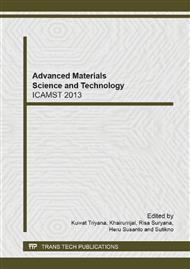p.485
p.489
p.493
p.497
p.502
p.506
p.510
p.517
p.521
The Formulation of Phonon as the Result of Second Quantization of Crystalline Lattice Vibration Using Wave Functional Method
Abstract:
Phonon is undoubtedly one of the most important concepts in the physics of materials. Phonon is the result when we quantize vibrational field. Whereas Schrodinger’s wave function method is the most popular and intuitive method in doing the first quantization, one usually uses Heisenberg’s operator method in the second quantization. We feel that there is a methodological and pedagogical discontinuity here. So in this paper we will use Schrodinger’s wave functional method to quantize the lattice vibration to produce phonons. Wave functional is difficult due to the nondenumerably infinite number of dimensions of its domain. In this paper we will approximate this infinity through the discrete nature of crystalline lattice so that phonon can be represented by wave function with many variables
Info:
Periodical:
Pages:
502-505
Citation:
Online since:
February 2014
Authors:
Price:
Сopyright:
© 2014 Trans Tech Publications Ltd. All Rights Reserved
Share:
Citation:


